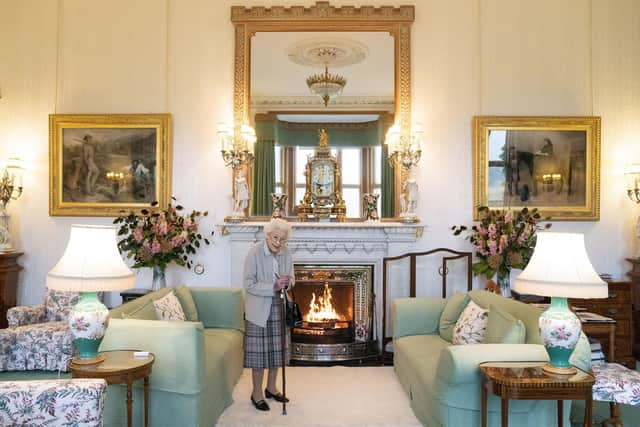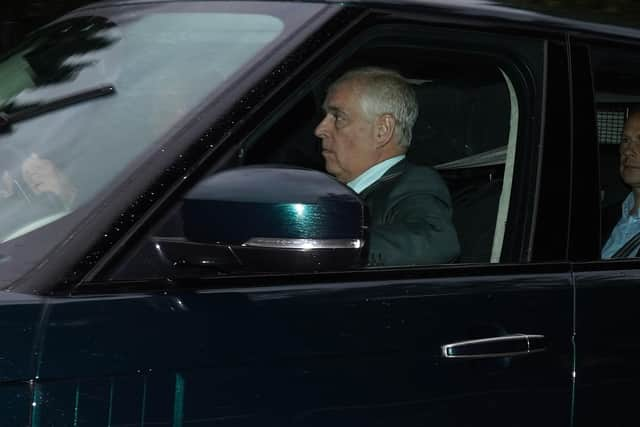Queen Elizabeth II death: End of an era as monarch dies aged 96 at her cherished Balmoral estate
With her death, her eldest son, Charles, the former Prince of Wales, is now king. The 73 year-old will be officially proclaimed as such at St James’s Palace in London as soon as possible.
In a statement from Buckingham Palace, King Charles III said: “The death of my beloved mother, Her Majesty the Queen, is a moment of the greatest sadness for me and all members of my family.
Advertisement
Hide AdAdvertisement
Hide Ad“We mourn profoundly the passing of a cherished sovereign and a much-loved mother. I know her loss will be deeply felt throughout the country, the realms and the Commonwealth, and by countless people around the world.”
The announcement of Elizabeth II’s death by Buckingham Palace at 6:30pm on Thursday deprives Britain of a figure who was a constant presence in the country’s life from the post-war era to the modern day.
Her tenure as head state spanned 15 prime ministers, from Winston Churchill through to Liz Truss, who met with the Queen at Balmoral only on Tuesday.
In that time, the monarch undertook 266 official overseas visits, sent more than 300,000 congratulatory messages to centenarians, and hosted over 1.5 million people at garden parties at Buckingham Palace and the Palace of Holyroodhouse.
But her legacy goes beyond mere statistics. She helped steer the monarchy through decades of turbulence, and although the institution she helmed faced its share of troubled times, it endured. Throughout it all, its matriarch never gave the impression the crown she wore was too heavy a burden to bear.


Throughout personal tragedies and torrid times facing the country, she remained a unifying and reassuring presence until the very end, helping to modernise the monarchy’s rule while undergoing fierce scrutiny.
Ms Truss was among a host of leaders around the world to pay tribute, as flags at the Palace of Holyroodhouse, the Scottish Parliament, and buildings around the country were lowered to half mast.
The new prime minister described Elizabeth II as the “rock on which modern Britain was built,” adding: “Our country has grown and flourished under her reign. Britain is the great country it is today because of her.”


Advertisement
Hide AdAdvertisement
Hide AdFirst Minister Nicola Sturgeon said the Queen’s death was a “profoundly sad moment” for the UK, the Commonwealth, and the world.
“For more than 70 years, she has been the great constant in our national life,” she said. “She has inspired us, on occasion comforted us, and always personified values we hold dear.”
While Elizabeth II’s health had been visibly deteriorating since last autumn, the end of her extraordinary 70-year reign in her Platinum Jubilee year was sudden.
After Buckingham Palace announced her doctors had expressed concern for her health shortly after 12:30pm, her closest family rallied to be by her side. The palace said the Queen was under medical supervision, and was comfortable, but the unprecedented nature of the announcement led many to fear the worst.
Less than six hours later, those fears were realised when the palace issued a two-line statement. Even if many expected the news, the sense of loss it conveyed was profound.
“The Queen died peacefully at Balmoral this afternoon,” it announced. “The King and The Queen Consort will remain at Balmoral this evening and will return to London tomorrow.”
Under darkening clouds and squalls of heavy rain, Charles had earlier arrived at Balmoral by helicopter with his wife – now the Queen Consort – having flown from Dumfries House in East Ayrshire. Elizabeth II’s only daughter, Princess Anne, was also at Balmoral, having been in Scotland to undertake engagements.
Her two other children, Prince Andrew and Prince Edward, joined Prince William and the Countess of Wessex as they too hurried north, flying to Aberdeen Airport aboard an RAF trijet aircraft, before William – now the heir to the throne – drove a Range Rover on the 45-mile journey to Balmoral.
Advertisement
Hide AdAdvertisement
Hide AdThey sped through the estate gates shortly after 5:05pm, where a crowd of well wishers had gathered in the gloomy weather to express support. It is not known whether they arrived before the Queen’s death. Prince Harry arrived at Balmoral around 8pm.
The events of Thursday leave a family mourning a mother, a grandmother, and a great-grandmother, but they also mark an immense and historic moment of change for the monarchy and Britain as a whole.
Less than 18 months have passed since the death of Elizabeth II’s beloved husband and companion, Philip, and the last year of her reign brought turmoil with the furore of the Duke of York’s civil sexual assault case, and the cash for honours scandal that engulfed one of Charles’s charities.
Elizabeth II, who had been experiencing ongoing mobility issues since last autumn, pulled out of a virtual Privy Council on Wednesday, a day after appointing Ms Truss as prime minister, with doctors ordering her to rest.
She also missed the annual Braemar Gathering last weekend, staying at Balmoral to watch a live stream of the proceedings.
During her Platinum Jubilee celebrations, she travelled to Buckingham Palace twice. Her role was formally re-written by the palace to scale back her ‘official duties’ in July, for the first time in more than a decade.
She also spent a night in hospital for tests in October last year and was ordered by doctors to rest for the next three months, missing the Remembrance Sunday Cenotaph service and COP26 climate change summit.
The Queen had been on a summer break at Balmoral since July 21. The Aberdeenshire estate, where she and her late sister, Princess Margaret, enjoyed endless summer holidays as young girls, served as a place of sanctuary throughout her reign.
For her grieving family, it offered a degree of comfort and privacy last night. But today brings a new dawn and, with it, a new beginning.
Comments
Want to join the conversation? Please or to comment on this article.
